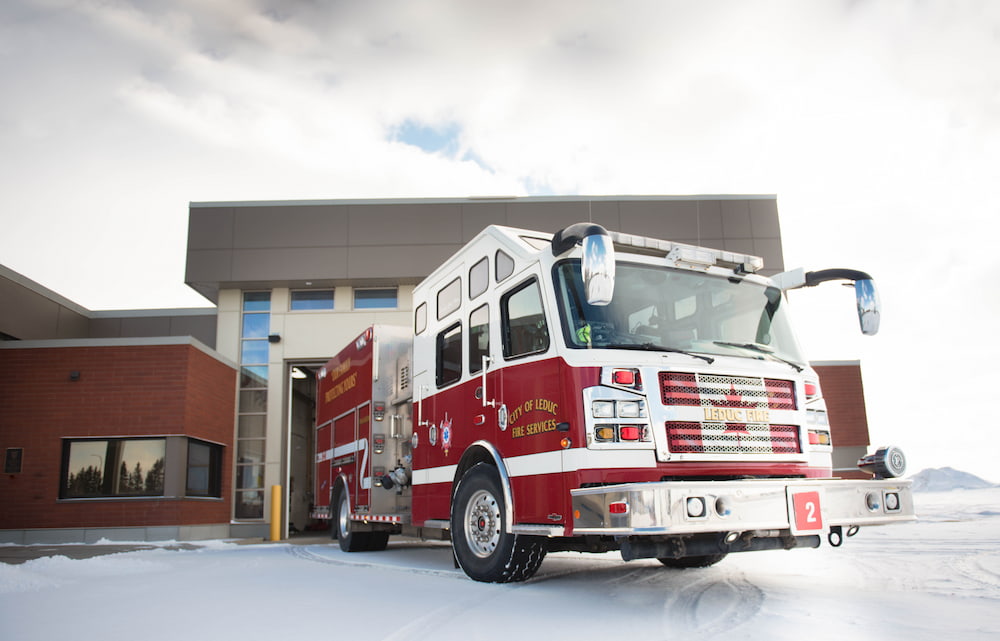Fire prevention and safety is important in reducing the risk and number of fires in the City of Leduc and surrounding region. Fire Prevention Officers work together with the community to support everyone in understanding how to be fire safe.
Ensuring every building in the City of Leduc complies with the National Fire Code – Alberta Edition, Fire Prevention Officers carry out inspections of commercial and residential properties (by request), along with special events.
Before any proposed developments are built or new businesses open, fire safety plans are to be submitted for review and approval through your permit application process. Plans ensure you are prepared for fire or emergency.
Fire Prevention Officers, with proper documentation, may issue:
- Fireworks/Pyrotechnic permits
- Open air burning permits
When you turn your clocks back in October, make a lifesaving change in your household–change the batteries in your smoke alarms. Working smoke alarms nearly cut in half the risk of dying in a home fire.
Smoke alarms are your first line of defence and alarm maintenance is a simple, effective way to reduce home fire deaths. The peak time for home fire fatalities is between 10pm – 6am when most families are sleeping.
Regardless of where a fire starts in a home, the structure can be engulfed in flames within minutes. The most commonly cited cause of non-working smoke alarms: worn or missing batteries.
Several times a year, particularly during the winter months, Fire Services respond to fires caused by improper disposal of hot ashes from wood-burning fireplaces.
Coals and ashes from fires can remain hot enough to start a fire for many hours or even days after you think the fire is out. The exact amount of time for complete extinguishment and cooling depends on many factors such as how hot the fire was, what was burning, how much unburned fuel remains.
To be safe, treat all ashes and coals as hot, even when you think they had time enough to cool. The following 3 simple steps will ensure your home doesn’t become a victim of careless disposal of hot ashes and coals:
- DO NOT remove hot ashes from the fireplace immediately. Wait 2-3 days and let the ashes cool completely until there are no remaining hot embers.
- NEVER put fireplace ashes in a combustible plastic trash container as it can easily ignite. If you have to remove the ashes from the fireplace before they are completely cool, put the ashes and hot embers in a metal bucket. Move the bucket outside the house/garage and well away from anything that is combustible.
- ONLY put fireplace ashes in your combustible plastic trash container once they are completely cool and after you have put your trash container out on the street for trash pickup.
If your household uses a wood or coal burning fire place it is equally important to have your chimney inspected and cleaned annually by a professional.
According to the Fire Services Bylaw, outdoor fire pits must be a minimum of 3m from buildings, property lines and other combustible material. The fire pit must not exceed 0.6m in height, and the opening must not exceed 1m in width at the widest points. The fire pit must be made of bricks, concrete blocks, heavy gauge metal or other non-combustible materials, and it must be covered with a mesh screen with openings no larger than 1.25cm.
Outdoor fire places must be a minimum of 1m from buildings, property lines or other combustible materials and must be built of material such as bricks or rocks that are heat and flame resistant. The fireplace must have a chimney that is not less than 2.5m in height, and it must have a regulation screen to reduce airborne sparks. The base of the burning area must not be less than 0.3m and must be between 0.4 – 0.6m deep.
- Burn only clean-burning dry wood, charcoal, or natural gas.
- Do NOT burn wet grass, plastic, painted or treated wood.
- Use kindling and build up your fire slowly for a controllable fire.
- Lighter fluid is an unpredictable and dangerous method to start a fire.
- Where the wind is taking the smoke—if it’s blowing right to your neighbour’s house, perhaps don’t have a fire that day.
- Keep chairs and other furniture at least 3f away from fire pits. It only takes a few seconds and a spark or flame to start a fire.
Leduc Fire Services in conjunction with Fire Prevention Week is targeting older neighbourhoods in the community to receive smoke/carbon monoxide alarms. As part of an ongoing fire prevention strategy, homes in the greater downtown area will receive an alarm or have existing units tested.
To qualify for the program, your residence has to have been constructed during or prior to 1978, you must be a senior citizen/older adult, have a disability and/or live on a low income. To receive one of these devices, fill out this form or contact Fire Services at (780) 980-8475.
In addition to working smoke alarms, the best defence against a fire is a well-rehearsed escape plan. Knowing exactly what to do can save precious seconds in the event of a real emergency. The Canada Safety Council recommends these steps to prepare your family fire escape plan:
- Draw a floor plan of your house.
- Mark 2 ways out of each room.
- Establish a meeting place outside the house.
- Be sure each family member has the plan and knows the escape route.
- Post your fire escape plan on the fridge or bulletin board.
- Hold a fire drill for your family once or twice a year. Vary the drills to practice escaping from different fire sources.

